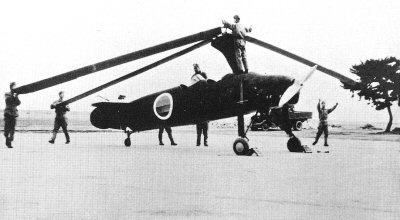Kayaba Army Observation Autogyro Ka-1 / Ka-2


The Imperial Japanese Army developed the Ka-1 autogyro for reconnaissance, artillery-spotting, and anti-submarine uses. The Ka-1 was based on an American design, the Kellett KD-1A, which had been imported to Japan in 1939, but which was damaged beyond repair shortly after arrival. The Kayaba factory was then asked by the Army First to develop a similar machine, and the first prototype was flying on 26 May 1941. The craft was initially developed for use as an observation platform and for artillery spotting duties. The Japanese Army liked the craft's short take-off span, and its low maintenance requirements. The production began in 1941 and the first autogyros were assigned to artillery units for artillery spotting. These carried two crewmen: a pilot and a spotter. Later, the Japanese Army commissioned a small aircraft carrier, Akitsu Maru, intended for coastal antisubmarine (ASW) duties. The Ka-1 was modified by eliminating the spotter's position in order to carry one small depth charge. The carrier was later sunk by American submarines on November 15, 1944. About 20 Ka-1 were made, and then production shifted to the Ka-2, which was basically the same aircraft with a different engine (the same Jacobs L-4MA-7 engine as the original Kellett KD-1). Total Ka-1 and Ka-2 production was approximately 240. No Allied codename was assigned. (info from Wikipedia)
Kayaba Army Observation Autogyro Ka-2
Type: autogyro for artillery spotting
Service: Japanese Army Air Force (JAAF)
Crew: Pilot and observer
Armament: up to 132 lb (60 kg) depth charges
Reference: Francillon: 145
Specifications:
Length: 30' 2.25" (9.2 m)
Rotor diameter: 40' 0.25" (12.2 m)
Empty Weight: 71709 lbs (775 kg)
Max Weight: 2579 lbs (1170 kg)
Propulsion:
No. of Engines: 1
Powerplant: Jacobs L-4MA-7 seven cylinder radial
Horsepower: 240 hp
Performance:
Range: 174 miles (280 km)
Cruise Speed: 71.5 mph (115 km/hr)
Max Speed: 102.5 mph (165 km/hr)
Climb to/in: 3280 ft (1000 m) in 3 min 20 sec
Ceiling: 11485 ft (3500 m)
Production: approximately 240 Ka-1s and one Ka-2
Additional information on this aircraft
can be found at Wikipedia
HERE.
For a very nice scale color drawing of this aircraft, see
here.
Additional color schemes for this aircraft can be found here.
If you don't see the table of contents at the left of your screen, CLICK HERE to see the rest of this website!